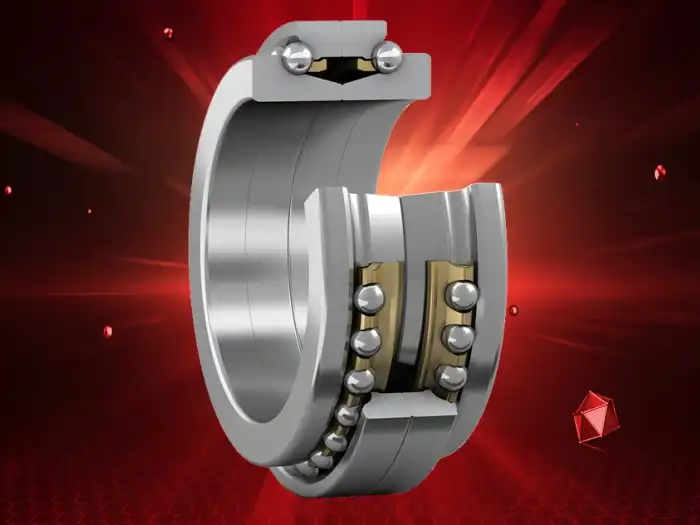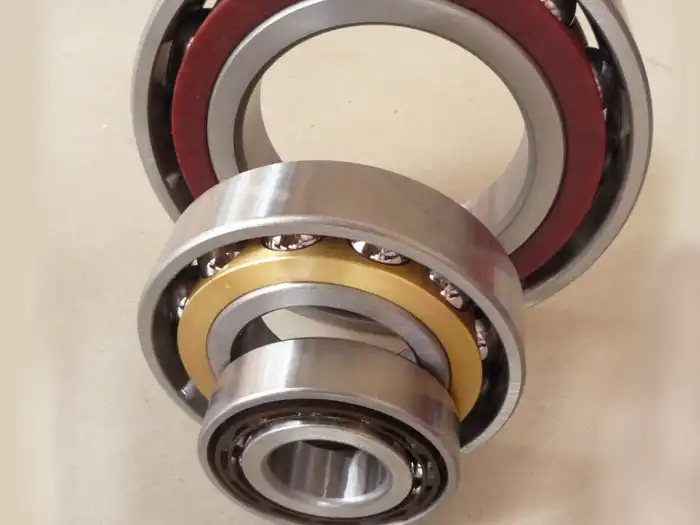What's the Role of Contact Angles in Angular Contact Ball Bearings?
Angular contact ball bearings are essential components in many industrial applications, offering a unique combination of radial and axial load-bearing capabilities. One of the key factors that determine their performance is the contact angle. This critical design element plays a significant role in how these bearings handle loads, distribute forces, and maintain precision during operation. The contact angle refers to the angle between the line joining the points of contact of the ball and the raceways in the radial plane, relative to a line perpendicular to the bearing axis. Understanding the role of contact angles is crucial for engineers and technicians involved in selecting and implementing angular contact ball bearings in various machinery and equipment. This article delves into the importance of contact angles, exploring how they influence bearing performance, load capacity, and overall efficiency in different applications.

How Does the Contact Angle Affect Load Capacity in Angular Contact Ball Bearings?
Impact on Axial Load Capacity
The contact angle in angular contact ball bearings significantly influences their axial load capacity. As the contact angle increases, the bearing's ability to handle axial loads improves. This is because a larger contact angle allows for a more direct transmission of axial forces through the balls to the raceways. In angular contact ball bearings with higher contact angles, such as 25° or 40°, the axial load capacity is substantially higher compared to those with smaller angles like 15°. This characteristic makes bearings with larger contact angles ideal for applications where high axial loads are anticipated, such as in machine tool spindles or pumps.
Effect on Radial Load Capacity
While increasing the contact angle enhances axial load capacity, it has an inverse effect on radial load capacity. Angular contact ball bearings with smaller contact angles, typically around 15°, are better suited for applications where radial loads are predominant. As the contact angle increases, the bearing's ability to handle radial loads decreases. This trade-off between axial and radial load capacities is a crucial consideration when selecting angular contact ball bearings for specific applications. Engineers must carefully evaluate the expected load conditions to choose the optimal contact angle that balances both axial and radial load requirements.
Influence on Combined Load Handling
In many real-world applications, angular contact ball bearings are subjected to both radial and axial loads simultaneously. The contact angle plays a vital role in determining how effectively the bearing can handle these combined loads. Bearings with moderate contact angles, such as 25°, often provide a good balance for applications with mixed load conditions. They offer improved axial load capacity compared to standard deep groove ball bearings while still maintaining reasonable radial load handling capabilities. This versatility makes angular contact ball bearings with moderate contact angles popular choices in a wide range of industrial equipment, from gearboxes to conveyor systems.
What Are the Benefits of Different Contact Angles in Angular Contact Ball Bearings?

Precision and Rigidity
The contact angle in angular contact ball bearings directly influences the bearing's precision and rigidity. Bearings with larger contact angles typically offer higher rigidity, which is crucial in applications requiring precise positioning and minimal deflection under load. This increased rigidity is particularly beneficial in machine tool spindles, where accuracy and stability are paramount. The enhanced stiffness provided by larger contact angles helps maintain tight tolerances and reduces the likelihood of vibration or chatter during high-speed operations. However, it's important to note that while larger contact angles improve rigidity, they may also increase friction and heat generation, which must be considered in the overall bearing design and application.
Speed Capabilities
The contact angle also plays a significant role in determining the speed capabilities of angular contact ball bearings. Generally, bearings with smaller contact angles are better suited for higher speed operations. This is because smaller contact angles result in reduced centrifugal forces acting on the balls at high rotational speeds. Bearings with 15° contact angles, for instance, are often preferred in high-speed applications such as electric motors or turbines. Conversely, bearings with larger contact angles may have limitations in terms of maximum operational speeds due to increased centrifugal forces and heat generation. However, advancements in bearing design and materials have led to the development of high-speed capable bearings with larger contact angles, expanding their application range.
Thermal Management
The contact angle in angular contact ball bearings also affects thermal management within the bearing. Bearings with smaller contact angles generally generate less heat during operation, making them suitable for applications where temperature control is critical. This is particularly important in high-speed applications or in environments where excessive heat could compromise lubricant performance or cause thermal expansion issues. On the other hand, bearings with larger contact angles may require more careful consideration of thermal management strategies, such as improved lubrication systems or external cooling, especially in high-load or high-speed scenarios. The choice of contact angle thus becomes a balancing act between load capacity, speed requirements, and thermal considerations in the specific application context.
How Do Contact Angles Influence the Lifespan of Angular Contact Ball Bearings?

Stress Distribution and Wear
The contact angle in angular contact ball bearings significantly influences stress distribution and wear patterns, which in turn affect the bearing's lifespan. Bearings with larger contact angles typically distribute stresses over a larger area of the raceway, potentially reducing localized wear and extending the bearing's operational life. This is particularly beneficial in applications with high axial loads. However, the increased contact area can also lead to higher friction and heat generation, which may accelerate lubricant degradation. Conversely, bearings with smaller contact angles may concentrate stresses over a smaller area but generally operate with lower friction. The optimal choice of contact angle for maximizing lifespan depends on the specific load conditions, speed requirements, and environmental factors of the application.
Lubrication Efficiency
Contact angles play a crucial role in the lubrication efficiency of angular contact ball bearings. The angle affects how lubricant is distributed and retained within the bearing during operation. Bearings with smaller contact angles typically require less lubricant and are more efficient in maintaining an adequate lubricating film, especially at high speeds. This can lead to reduced friction and heat generation, potentially extending the bearing's service life. In contrast, bearings with larger contact angles may require more careful consideration of lubrication strategies to ensure proper oil film formation and retention, particularly under heavy axial loads. The choice of contact angle thus becomes an important factor in designing an effective lubrication system that optimizes bearing performance and longevity.
Fatigue Life Considerations
The contact angle in angular contact ball bearings has a direct impact on the bearing's fatigue life. The angle influences the size and shape of the contact ellipse between the balls and raceways, which in turn affects subsurface stress patterns and potential fatigue initiation points. Larger contact angles generally result in larger contact ellipses, which can distribute loads over a greater area and potentially increase the bearing's resistance to fatigue. However, this must be balanced against the increased friction and heat generation associated with larger contact angles. In applications where fatigue life is a critical consideration, such as in aerospace or heavy industrial equipment, the selection of the appropriate contact angle becomes a crucial design decision, often requiring detailed analysis and testing to optimize bearing performance and longevity.
Conclusion
The role of contact angles in angular contact ball bearings is crucial in determining their performance, load-bearing capacity, and lifespan. From influencing axial and radial load capacities to affecting precision, speed capabilities, and thermal management, the contact angle is a key factor in bearing design and selection. As we've explored, different contact angles offer varying benefits and trade-offs, making it essential for engineers and technicians to carefully consider application requirements when choosing the right bearing.
Luoyang Huigong Bearing Technology Co., Ltd., established in 1998, is a high-tech enterprise specializing in the design, development, production, and sales of high-reliability, long-lifespan rolling mill bearings, precision thin section bearings, cross roller bearings, and high-end large rollers. Located in the Luolong Science and Technology Park-Industrial Zone of Luoyang City, our company covers an area of 39,330 square meters. With a registered capital of 31 million and over 240 employees (29% of whom are technicians and intermediate and senior engineers), we are well-equipped to meet diverse bearing needs. Our state-of-the-art facility includes more than 150 sets of main production equipment and over 70 sets of various testing equipment, enabling an annual production capacity of 30,000 sets of long-life mill bearings, 40,000 sets of high-precision thin section bearings, and 10 million pieces of high-end large rolling elements. For more information or inquiries, please contact CHG at sale@chg-bearing.com.
References
1. Smith, J. D. (2013). "Modern Tribology Handbook, Two Volume Set." CRC Press.
2. Harris, T. A., & Kotzalas, M. N. (2006). "Essential Concepts of Bearing Technology." CRC Press.
3. Hamrock, B. J., & Anderson, W. J. (1983). "Rolling-Element Bearings." NASA Reference Publication 1105.
4. SKF Group. (2018). "Rolling Bearings Catalogue." SKF Group.
5. Palmgren, A. (1959). "Ball and Roller Bearing Engineering." S. H. Burbank & Co., Inc.
6. Eschmann, P., Hasbargen, L., & Weigand, K. (1985). "Ball and Roller Bearings: Theory, Design and Application." John Wiley & Sons.

